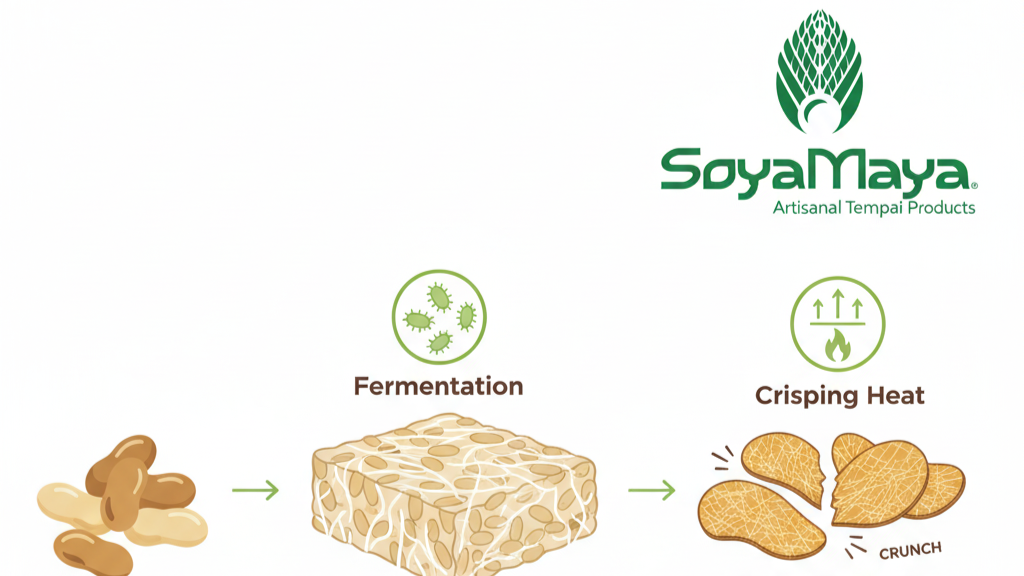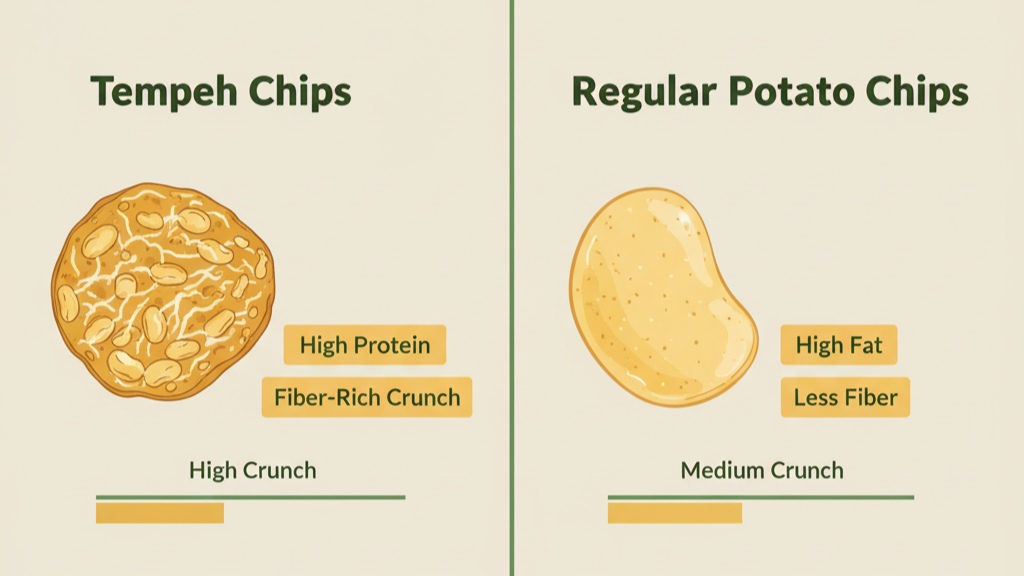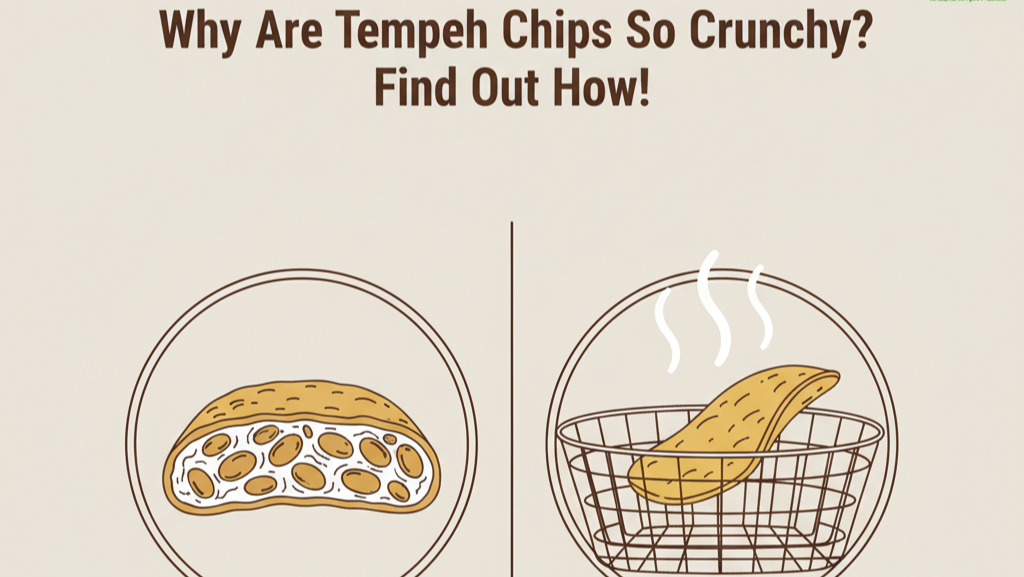Tempeh chips get their crunch from the dense, fibrous structure of fermented soybeans combined with thin slicing and high-heat cooking that quickly removes moisture. When we first tried SoyaMaya tempeh chips, we was struck by how their crispness felt different from regular potato chips, more substantial and with a satisfying nutty flavor.
This unique crunch comes from the natural protein and fiber in the soybeans firming up during baking or frying. If you’re curious about what makes these chips so crunchy and why they stand out as a healthy snack option, keep reading to find out more.
Key Takeaway
- Tempeh chips get their crunch from fermented soybeans’ dense protein and fiber structure.
- Thin slicing and high-heat baking or frying rapidly dehydrate the chips, locking in crispness.
- Light coconut oil and sea salt seasoning enhance texture and flavor without heaviness.
The Allure of the Crunch: Why We Love Crunchy Snacks

Remember that feeling when you bite into something perfectly crispy? That’s what got us started at SoyaMaya. Working in our test kitchen, we’d spend hours just listening to different snacks – the loud snap of a carrot stick, the gentle crackle of roasted chickpeas, the satisfying crunch of tempeh chips. There’s something almost primal about it, like our bodies know exactly what they want.
We’ve noticed people reach for crunchy snacks when they’re stressed, celebrating, or just need a pick-me-up. It’s not just about hunger – it’s about satisfaction. The thing is, most snacks that deliver that perfect crunch come loaded with artificial stuff that leaves you feeling off afterward. We kept running into this problem ourselves, and that’s what pushed us to experiment with tempeh.
Our small-batch fermentation process creates this amazing texture that’s totally different from regular chips. It’s what defines what makes them crunchy and savory tempeh chips , that satisfying crisp balanced with real nutrition. When we first nailed the recipe, we couldn’t stop munching, but unlike with other crunchy snacks, we didn’t get that heavy, blah feeling afterward. The natural fermentation actually helps your body process the nutrients better.
We’ve learned through countless taste tests (some definitely better than others) that the right crunch has to hit three notes: it needs to be loud enough to feel satisfying, light enough to keep snacking, and sturdy enough to hold up to dipping. That’s why we take extra time with each batch of our tempeh chips, making sure they nail that perfect crisp every time.
Tempeh 101: The Foundation of a Crunchy Chip

Out in the humid Indiana summers, we spend a lot of time with our soybean farmers. They’ve taught us more about these little beans than we ever thought possible – like how the soil composition affects protein content, or why some seasons produce naturally sweeter crops. It’s amazing how something so simple becomes the backbone of our crunchy snacks.
The magic really happens during fermentation. We use a traditional process that’s been around for centuries – whole soybeans get cooked, cooled, and then meet their friend, a natural culture that weaves the beans together. Think of it like nature’s glue, but way better for you. The beans knit together over 36 hours in our temperature-controlled rooms (we learned the hard way that tempeh’s pretty picky about its climate).
What gets us excited is watching the transformation. Those loose soybeans become this dense, white cake with a nutty smell that fills our whole facility. The fermentation does more than just bind things together – it breaks down the beans in a way that makes their nutrients easier to absorb. Plus, it creates this perfect structure that, when sliced thin and baked, turns into the crunchiest chips you’ve ever tried.
We work with five family farms within 50 miles of our facility. Each delivery of soybeans comes with stories about the growing season – whether it was too wet, too dry, or just right. This connection means we know exactly what’s going into our tempeh, right down to which field it came from. Sometimes we can even taste subtle differences between batches, like how beans from the riverside fields have a slightly sweeter note.
The best part? All this care in the beginning stages means we don’t need to add much when making our chips. The fermentation creates such complex flavors that we can keep the ingredient list short and simple – just the way snacks should be.
The Science of the Crunch: Key Factors at Play

The Soybean Matrix: Protein and Fiber Power
One big reason tempeh chips are crunchy is the composition of tempeh itself. The dense protein and fiber from the soybeans create a firm network that crisps up well when cooked. Unlike regular potato chips that rely mostly on starch, tempeh’s fibrous matrix hardens during baking or frying, giving a crisp that’s more substantial and less greasy. [1]
Thin Slicing: Setting the Stage for Crispness
The thickness of the slices matters. Thin slices dehydrate faster and crisp up evenly without sogginess. At SoyaMaya, we slice the tempeh thinly so every chip gets that perfect golden brown, crispy texture.
The Magic of Baking or Frying: Dehydration and Texture
When tempeh slices bake or fry at high heat, moisture quickly evaporates. This drying step is key , it changes the texture from soft and chewy to firm and brittle, creating that signature satisfying crunch. The process also locks in the nutty flavor and prevents the chips from feeling heavy.
Oil and Seasonings: Enhancing the Crunch and Flavor
A light coating of coconut oil helps the chips crisp up beautifully and adds a subtle richness. We finish with a sprinkle of light sea salt to enhance the natural sea salt flavor without overpowering the tempeh’s nutty taste. The result is a balanced flavor profile that’s salty but clean, unlike some chips that taste overly salty or oily.
Tempeh Chips vs. Other Chips: A Crunch Comparison

We’ve munched our way through countless chips while developing our tempeh snacks. The difference hits you right away – where regular chips leave that greasy film on your fingers, our tempeh chips have a clean, crisp bite that doesn’t weigh you down. The crunch isn’t just louder; it’s more satisfying, like biting into a perfectly toasted slice of sourdough.
Through countless taste tests in our kitchen, we’ve noticed tempeh chips have this unique texture that comes from the natural fermentation process. The soybeans create these tiny air pockets that make each bite both light and substantial. You get that satisfying crackle without the heavy feeling afterward.
The nutrition differences really stand out too. While regular chips might give you 1-2 grams of protein per serving, our tempeh chips pack in 7 grams – about the same as an egg. It’s one of the reasons many consider tempeh chips better than potato chips, thanks to their higher protein and cleaner crunch. The fermentation process adds good bacteria (like the kind you’d find in yogurt) and makes the nutrients easier for your body to use. We’ve found people can snack longer without that crash that comes from traditional chips.
What’s really cool is how versatile these are. They hold up great with dips (we’ve tested everything from hummus to guacamole), and they don’t get soggy like other chips. Plus, since we’re not masking the natural flavors with tons of salt or artificial seasonings, you can actually taste the subtle, nutty notes from the fermented soybeans.
Achieving the Ultimate Crunch: Tips for Making Tempeh Chips at Home
Credits : Anfa Pedia
If you want to try making tempeh chips yourself, here’s what we’ve learned: [2]
- Start with good-quality fermented tempeh, preferably organic.
- Slice it thin to help it crisp evenly.
- Lightly coat with coconut oil before cooking.
- Season simply with sea salt or your favorite spices.
- Bake or fry at high heat to rapidly remove moisture and set the crunch.
Still, after experimenting at home, We find that our SoyaMaya tempeh protein chips deliver that consistent satisfying crunch and nutty flavor that’s pretty neat. They’re a snack we can enjoy guilt-free and feel good about.
Crunchy Benefits You Can Count On with SoyaMaya Tempeh Chips
When we talk about benefits at SoyaMaya, we’re not just throwing around buzzwords – we’re sharing what we’ve learned from years of making these snacks. Every batch of our tempeh chips starts with whole soybeans from farms we actually visit. These beans pack about 15 grams of protein per serving before we even start the fermentation process.
During fermentation, something pretty cool happens. The natural culture breaks down those beans, making their nutrients easier for your body to use. We’ve noticed people who usually have trouble digesting soy products can enjoy our chips without issues. That’s the power of traditional fermentation – it’s like the beans get pre-digested.
The fiber content stays intact too – about 6 grams per serving. That’s nearly a quarter of what you need daily. And since we don’t strip away any of the natural goodness, you’re getting iron, calcium, and B-vitamins that your body craves. It’s also a great option for anyone curious if tempeh chips are good for building muscle or searching for a crunchy snack alternative that keeps snack time satisfying. We keep the ingredient list simple because, honestly, the tempeh does most of the heavy lifting flavor-wise.
Working with local Indiana farmers means we’re helping preserve family farms that have been around for generations. We put 5% of our profits into local school nutrition programs because we believe good eating habits start young. Some days, we’ll get letters from teachers telling us how their students are more interested in learning about food science after trying our chips – that makes all those long hours in the test kitchen worth it.
Each crunchy bite isn’t just filling your stomach – it’s supporting real people and real change in our community. And yes, they still taste good enough that we have to keep ourselves from snacking on them all day at the factory.
FAQ
How is making tempeh at home different from producing fried tempeh chips in stores?
Making tempeh at home involves fermenting soybeans with Rhizopus oligosporus for about two days until the soy forms a firm cake. In contrast, fried tempeh chips are made by slicing, frying, and seasoning the fermented soybean pieces to create crispy tempeh chips. Commercial methods ensure even texture, longer shelf life, and a consistent satisfying crunch.
What are the health benefits of eating tempeh snacks made from fermented soybeans?
Tempeh snacks made from fermented soybeans offer several health benefits. They are rich in plant based protein, support digestive health through good bacteria, and provide essential vitamins and minerals. Unlike regular chips that often contain empty calories, tempeh snacks nourish the body while maintaining great taste and texture.
How do tempeh chips compare to regular potato chips in nutrition and flavor profile?
Tempeh chips differ from regular potato chips in both nutrition and flavor profile. They have more grams of protein per serving, fewer empty calories, and contain heart healthy fats. Their nutty flavor and golden brown texture give them a wholesome, satisfying crunch that regular chips usually lack.
Why are soya maya tempeh chips considered a plant based protein snack with a unique story?
Soya Maya tempeh chips reflect how an ancient Indonesian fermentation tradition evolved into a modern plant based protein snack. Founded by Mayasari Effendi, the brand began in an American kitchen inspired by Indonesian fermentation. Each tempeh chips pack combines fermented foods, sea salt flavor, and high soy protein content , a pretty neat cultural and nutritional blend.
Conclusion
If you want to try crunchy snacks that bring together flavor, texture, and nutrition, We recommend starting with SoyaMaya’s tempeh protein chips. They offer a golden brown, crispy tempeh experience with a nutty flavor and light sea salt seasoning that’s hard to beat.
Check them out here: SoyaMaya Shop.
References
- https://cookindocs.com/indonesian-tempeh-chips-recipe/
- https://buttereats.com/crispy-tempeh-chips/

